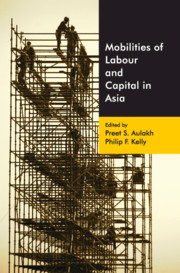1 - Introduction: Conceptualizing Labour and Capital Mobilities In and Out of Asia
Published online by Cambridge University Press: 24 December 2019
Summary
Capitalist development has always, and everywhere, been characterized by the restless mobility of both capital and labour. While these two forms of mobility are fundamentally related, it is unusual to combine the study of both or seek connections between them. In an effort to make these connections more than three decades ago, Saskia Sassen commented that the two processes of capital and labour mobility ‘have been constructed into unrelated categories’ (1988: 12). This assessment still largely holds true. The objective of this book is to explore the links between these forms of mobility with a particular focus on Asia.
While the imperative to be mobile is well established as a systemic feature of capital, it is usually studied through frameworks that try to understand the behaviour of firms, conglomerates, production networks, or investors. An extensive body of literature addresses corporate structures and strategies of capital accumulation. For example, in the field of international business, attention has traditionally focused on the mobility of capital, primarily through foreign direct investment (FDI) (for example, Dunning, 1988). The underlying assumption is the immobility of labour. The multinational corporation, with its proprietary capital and know-how (ownership advantage) and governance within a hierarchical organization (internalization advantage), facilitates the mobility of capital in order to take advantage of location-bound factors of production (including labour). Other approaches have addressed the networks and supply chains in which firms are situated. There have been, for example, significant efforts at understanding the spatial structures of production through the lenses of global commodity chains and global production networks. These bodies of literature point out that significant levels of spatial flexibility and mobility in production capital have been created through non-ownership modes of control such as subcontracting (Gereffi and Korzeniewicz, 1994; Coe and Yeung, 2015). Complementing this work are studies that focus on corporate international expansion trajectories and governance structures to manage globally dispersed investments (for example, Cuervo-Cazurra and Ramamurti, 2014; Ramamurti and Singh, 2009). Labour seldom features centrally in such accounts, except as an in situ characteristic of a particular place, valued for its skills, affordability, or docility. At the human scale, it is usually the investor or manager who is assumed to be mobile, but mostly it is the spatial configuration of capital itself (through FDI, corporate structures, commodity trade, debt, and so on) that receives attention.
- Type
- Chapter
- Information
- Mobilities of Labour and Capital in Asia , pp. 1 - 28Publisher: Cambridge University PressPrint publication year: 2020



